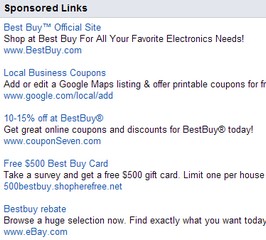Some of the world’s biggest companies are also the web’s biggest typosquatters.
I’ve written several times about how Microsoft (NASDAQ: MSFT) is one of the world’s biggest typosquatters. The company sues people who register typos of its brands, but when users type a non-existent web address into many Internet Explorer browsers they are sent to a Microsoft search page. This page includes sponsored links, from which Microsoft earns money.
But Microsoft is not alone. Many large companies are teaming up to snag typo traffic and generate money.
I recently purchased a Gateway (NYSE: GTW) desktop computer. Gateway struck a deal with Google (NASDAQ: GOOG) to add an application called “Browser Address Error Redirector” to Internet Explorer. This application serves up a page full of ads when you type in a non-existent URL. What’s worse, it even redirects non-existent subdomains.
Here’s an example for Azoogle, an affiliate program provider I use. Azoogle’s actual web site is AzoogleAds.com, but when you type in Azoogle.com it forwards to AzoogleAds.com. The login page for affiliates is login.azoogleads.com.
Sometimes I accidentally type login.azoogle.com instead of login.azoogleads.com. I forget the ‘ads’ at the end of the URL. login.azoogle.com doesn’t exist, and Google’s “Browser Address Error Redirector” serves up a page of advertisements. Gateway and Google share the revenue from these ads.
Note above how Browser Address Error Redirector forwards to a page hosted by Google. The invalid URL is the second highlighted field.
The good news for trademark holders is that these redirect pages are often horribly targeted, showing ads for insurance and mortgages when a page should be about affiliate programs. But If I type BestBuyyyy.com into my browser, the ads on the page include paid ads for BestBuy:
Alas, at least Gateway is an equal opportunity typosquatter. Type Gatewayyy.com into the browser and I get a page full of Gateway ads.








There’s a huge difference between owning a domain name which infringes someone’s mark and having a web page or a piece of software which carries adverts.
Which one would you say is worse?
The important question is in order to infringe a mark does it need to be seen (i.e. displayed or represented)? Or does any use, even unseen [by the end user] use, of the mark constitute an infringement?
If it’s the latter then the PPC & Search industries are probably going to require a major rethink.
I just don’t see infringement. You agreed to this. I don’t own a Gateway machine. So I don’t see the Gateway webpage. Just reconfigure the software on your machine.
Jay, I look at this and say they are typosquatting. Most companies that are typosquatted against say their trademarks are being infringed.
Funny thing, check this out:
http://tinyurl.com/yqg2gv
I hate to gripe, but it can be frustrating when other sites basically copy your posts without at least referring to them 🙂
It can be worse. There are some sites that literally cut and paste my posts into their sites, apparently with no regards to copyright law.
To “Editor”:
…Or perhaps someone else had the same experience that you did and wrote about it independently. Or maybe YOU’RE the copycat. Poor loser.
Also, REAL computer people don’t waste their time with vendor-installed OSes. Anyone with any REAL experience knows that EVERY vendor sells a junked-up PC. Format and reinstall…’nuff said.
Cameron, I know the exact chain of how this guy found the post, after I posted mine. But that\’s beside the point. You\’re right, I shouldn\’t complain. It just bothers me.
MOST people use vendor installed OSes. Some computer manufacturers are thinking about offering non-junked up systems for an extra fee.